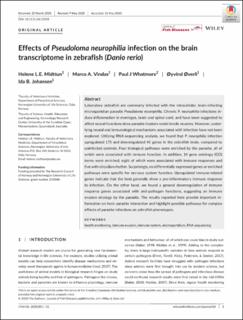Effects of Pseudoloma neurophilia infection on the brain transcriptome in zebrafish (Danio rerio)
Midttun, Helene Louise Eghave; Vindas, Marco; Whatmore, Paul J; Øverli, Øyvind; Johansen, Ida Beitnes
Peer reviewed, Journal article
Published version
Permanent lenke
https://hdl.handle.net/11250/2661535Utgivelsesdato
2020Metadata
Vis full innførselSamlinger
Sammendrag
Laboratory zebrafish are commonly infected with the intracellular, brain‐infecting microsporidian parasite Pseudoloma neurophilia . Chronic P. neurophilia infections induce inflammation in meninges, brain and spinal cord, and have been suggested to affect neural functions since parasite clusters reside inside neurons. However, underlying neural and immunological mechanisms associated with infection have not been explored. Utilizing RNA‐sequencing analysis, we found that P. neurophilia infection upregulated 175 and downregulated 45 genes in the zebrafish brain, compared to uninfected controls. Four biological pathways were enriched by the parasite, all of which were associated with immune function. In addition, 14 gene ontology (GO) terms were enriched, eight of which were associated with immune responses and five with circadian rhythm. Surprisingly, no differentially expressed genes or enriched pathways were specific for nervous system function. Upregulated immune‐related genes indicate that the host generally show a pro‐inflammatory immune response to infection. On the other hand, we found a general downregulation of immune response genes associated with anti‐pathogen functions, suggesting an immune evasion strategy by the parasite. The results reported here provide important information on host–parasite interaction and highlight possible pathways for complex effects of parasite infections on zebrafish phenotypes.

